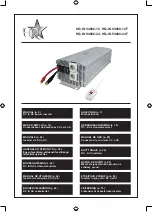
P A G E 1 1
Operating a Microwave oven with Your Power Inverter
The power rating used with microwave ovens is the "cooking power" which means the
power being "delivered" to the food being cooked. The actual operating power
requirement rating is on the back of the microwave. If the operating power
requirement cannot be found on the back of the microwave, check the owner's
manual or contact the manufacturer.
Safety Precautions
For best results place the power inverter on a reasonably flat surface.
• Keep the inverter dry. Do not expose it to rain or moisture. Do not operate the
inverter if the device being operated or any other surfaces that may come in contact
with any power source are wet. Water and many other liquids can conduct electricity
which may lead to serious injury or death.
• Avoid placing the inverter on or near heating vents, radiators or other sources of
heat. Do not place the inverter in direct sunlight. Ideal air temperature should be
between 50°F and 80°F.
• In order to properly disperse heat generated while the inverter is in operation, keep
it well ventilated. While in use, maintain several inches of clearance around the top
and sides of the inverter.
• Do not use the inverter near flammable materials. Do not place the inverter in
areas such as battery compartments where fumes or gases may accumulate.
•
When the inverter will be operating appliances with high continuous load ratings for
extended periods, it is not advisable to power the inverter with the same battery used
to power your car or truck. If the car or truck battery is utilized for an extended period,
it is possible that the battery voltage may be drained to the point where the battery
has insufficient reserve power to start the vehicle.
• It may be advisable to operate the inverter from a bank of batteries of the same
type in a "parallel" configuration. Two such batteries will generate twice the
amp\hours of a single battery; three batteries will generate three times the amp hours
and so on












































